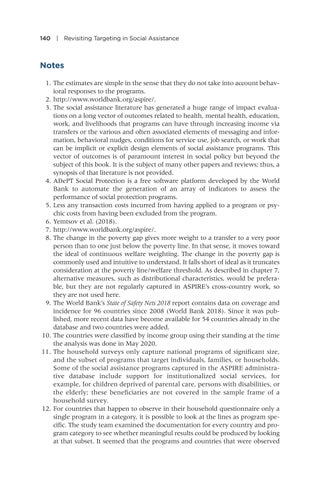140 | Revisiting Targeting in Social Assistance
Notes 1. The estimates are simple in the sense that they do not take into account behavioral responses to the programs. 2. http://www.worldbank.org/aspire/. 3. The social assistance literature has generated a huge range of impact evaluations on a long vector of outcomes related to health, mental health, education, work, and livelihoods that programs can have through increasing income via transfers or the various and often associated elements of messaging and information, behavioral nudges, conditions for service use, job search, or work that can be implicit or explicit design elements of social assistance programs. This vector of outcomes is of paramount interest in social policy but beyond the subject of this book. It is the subject of many other papers and reviews; thus, a synopsis of that literature is not provided. 4. ADePT Social Protection is a free software platform developed by the World Bank to automate the generation of an array of indicators to assess the performance of social protection programs. 5. Less any transaction costs incurred from having applied to a program or psychic costs from having been excluded from the program. 6. Yemtsov et al. (2018). 7. http://www.worldbank.org/aspire/. 8. The change in the poverty gap gives more weight to a transfer to a very poor person than to one just below the poverty line. In that sense, it moves toward the ideal of continuous welfare weighting. The change in the poverty gap is commonly used and intuitive to understand. It falls short of ideal as it truncates consideration at the poverty line/welfare threshold. As described in chapter 7, alternative measures, such as distributional characteristics, would be preferable, but they are not regularly captured in ASPIRE’s cross-country work, so they are not used here. 9. The World Bank’s State of Safety Nets 2018 report contains data on coverage and incidence for 96 countries since 2008 (World Bank 2018). Since it was published, more recent data have become available for 54 countries already in the database and two countries were added. 10. The countries were classified by income group using their standing at the time the analysis was done in May 2020. 11. The household surveys only capture national programs of significant size, and the subset of programs that target individuals, families, or households. Some of the social assistance programs captured in the ASPIRE administrative database include support for institutionalized social services, for example, for children deprived of parental care, persons with disabilities, or the elderly; these beneficiaries are not covered in the sample frame of a household survey. 12. For countries that happen to observe in their household questionnaire only a single program in a category, it is possible to look at the lines as program specific. The study team examined the documentation for every country and program category to see whether meaningful results could be produced by looking at that subset. It seemed that the programs and countries that were observed


